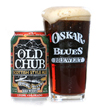The Fine Art of Packaging Beer
By David Hartley
Believe it or not, cans and screwtops are not only back, but they are chic.

For the past few decades, drinking beer out of a can has been for the slightly louche among us, the thin tin package of choice for undiscriminating guzzlers at football stadiums and frat-houses. But now the lowly can, once crushed for sport, is becoming fashionable, partly because bottling was the cheapest method of production. .
If microbrewers wanted to can their beer, they would have to contract the work to a bigger brewery. It wasn’t until Canadian brewer Kersten Kloss came up with an affordable canning line that he was able to convince major can producers in America to drop the minimum required order size to a level that independent brewers could afford to work with.

Thanks to Kloss, microbreweries could use the can, but now there was the marketing challenge: the craft beer drinking population believed that high-end beers only came in bottles. The original leaders of the microbrewing bonanza —Anchor Steam, Sierra Nevada, and Samuel Adams — distinguished themselves from corporate breweries by using bottles, and placing their products with imported beers, away from the rows and rows of six-pack cans that filled the domestic shelves of liquor stores.
In 2002, Colorado-based Oskar Blues brewery became the first U.S. microbrewery to brew and can its own beer, a move that all started as a joke. A line at the Oskar Blues website reads, “We started hand-canning our beer two cans at a time. We thought the idea of our bold, hoppy pale ale squeezed into a little can was hilarious. It made us laugh for weeks.”
But that self-deprecating attitude hides a truth: Oskar Blues had learnt something essential about the craft; that cans are actually better for beer quality, despite the aesthetic and class stereotypes.
The return to the can comes at a time that another metal symbol of alcoholic lore is making a comeback on the American wine market: the screwcap, or, in official parlance, the Stelvin closure. Why?
It is estimated that one out 20 wines are lost to cork taint. A wine becomes “corked” when air leaks through the seal, speeding the aging process of the wine. When the consumer opens the wine they are overwhelmed by the distinct smell of wet newspaper and moldy grapes.
Cork is becoming increasingly hard to get and expensive. Moreover, it has always been an imperfect seal; the Stelvin closure is a natural solution. Unfortunately, when the wine drinking population saw their chi-chi drink in bottles without cork they were shocked, confused, and turned off. They associated the screwcap with jug wines like Thunderbird, cheap magnums of white zinfandel, and their grandfather’s swilling wine. To some, the revival of the Stelvin closure remains as unthinkable as drinking champagne from a can, even though the bubbly is now being made by film legend Francis Ford Coppola; it is named for his daughter Sofia and packaged in a pink can.
After a few years of dealing, by necessity, with screwtops, the wine-drinking public has become accepting, if only half-heartedly. No such problem for beer drinkers, who are converting to the can across the country. They know that what counts is the strength of the brew, not shape of the package.
A Brief Guide to Great Canned Beer
Dales Pale Ale: Medium amber color, aromatic hops pour from the glass; Beer is balanced by hints of caramel sweetness from the malt; Finishes clean and bitter without being overwhelming. (Hear how, in 2002, Oskar Blues became the first US microbrewery to brew and can its own beer. It started hand canning its beer two cans at a time, on a small table-top machine.)
Old Chub Scottish Style Ale: Dark, almost black, color; hints of burnt chocolate and smoke sneak from the glass; Smooth creamy body; Finishes hearty with being heavy; Almost impossible to believe the alcohol content is 8 percent.
New England Brewing Company Atlantic Amber: Beautiful ruby color; toasted biscuit floats from the glass; Extremely malty and heavy, almost like a lager; Finishes with a huge does of hops, atypical of an amber; If anything, may be overwhelming after the second can.
Brooklyn Lager: Amber, gold color; Nose gives off hints of coriander and spice; Classic lager-style malt is balanced by notes of floral hops; Finish is strong without being overwhelming.

Excellent article, very information. I have recently acquired a taste for champaigne, but the bottles were too big to finish at one sitting, (sometimes) now I will look for the pink little can.
[…] Jump to Comments The Baron’s upstanding upstairs neighbor The Arts Fuse had a post recently on a subject near and dear to the Baron’s heart: […]